Metabolite Contents and Antioxidant Activities of Soybean (Glycine max (L.) Merrill) Seeds of Different Seed Coat Colors
Abstract
:1. Introduction
2. Materials and Methods
2.1. Chemicals and Reagents
2.2. Soybean Cultivation and Sample Preparation
2.3. Determination of Total Protein Content
2.4. Determination of Total Oil Content
2.5. Fatty Acid Analysis Using Gas Chromatography Coupled to Flame Ionization Detector
2.6. Total Phenolic Content and Antioxidant Activities
2.6.1. Extraction and Determination of TPC
2.6.2. DPPH-Radical Scavenging Activity
2.6.3. TEAC Assay
2.6.4. FRAP Assay
2.7. Data Analysis
3. Results and Discussion
3.1. Total Protein and Total Oil Contents
3.2. Fatty Acid Contents
3.3. Total Phenolic Content and Antioxidant Activities
3.4. Principal Component, Hierarchical Cluster and Correlation Analysis
4. Conclusions
Supplementary Materials
Author Contributions
Funding
Institutional Review Board Statement
Informed Consent Statement
Data Availability Statement
Conflicts of Interest
References
- Fisk, I.D.; Gray, D.A. Soybean (Glycine max) oil bodies and their associated phytochemicals. J. Food Sci. 2011, 76, 1349–1354. [Google Scholar] [CrossRef] [PubMed] [Green Version]
- Huang, J.; Ma, Q.; Cai, Z.; Xia, Q.; Li, S.; Jia, J.; Chu, L.; Lian, T.; Nian, H.; Cheng, Y. Identification and mapping of stable QTLs for seed oil and protein content in Soybean [Glycine max (L.) Merr.]. J. Agric. Food Chem. 2020, 68, 6448–6460. [Google Scholar] [CrossRef]
- Lee, K.J.; baek, D.Y.; Lee, G.A.; Cho, G.T.; So, Y.S.; Lee, J.R.; Ma, K.M.; Chung, J.W.; Hyun, D.Y. Phytochemicals and antioxidant activity of Korean black soybean (Glycine max L.) landraces. Antioxidants 2020, 9, 213. [Google Scholar] [CrossRef] [Green Version]
- Cho, K.M.; Ha, T.J.; Lee, Y.B.; Seo, W.D.; Kim, J.Y.; Ryu, H.W.; Jeong, S.H.; Kang, Y.M.; Lee, J.H. Soluble Phenolics and Antioxidant Properties of Soybean (Glycine max L.) Cultivars with Varying Seed Coat Colours. J. Funct. Foods 2013, 5, 1065–1076. [Google Scholar] [CrossRef]
- Messina, M.; Rogero, M.M.; Fisberg, M.; Waitzberg, D. Health impact of childhood and adolescent soy consumption. Nutr. Rev. 2017, 75, 500–515. [Google Scholar] [CrossRef] [PubMed] [Green Version]
- Friedman, M.; Brandon, D.L. Nutritional and health benefits of soy proteins. J. Agric. Food Chem. 2001, 49, 1069–1086. [Google Scholar] [CrossRef] [PubMed]
- Assefa, Y.; Bajjalieh, N.; Archontoulis, S.; Casteel, S.; Davidson, D.; Kovács, P.; Naeve, S.; Ciampitti, I.A. Spatial characterization of soybean yield and quality (amino acids, oil, and protein) for United States. Sci. Rep. 2018, 8, 14653. [Google Scholar] [CrossRef] [Green Version]
- Grundy, S.M. What is the desirable ratio of saturated, polyunsaturated, and monounsaturated fatty acids in the diet? Am. J. Clin. Nutr. 1997, 66, 988S–990S. [Google Scholar] [CrossRef] [Green Version]
- Lee, J.; Hwang, Y.S.; Kim, S.T.; Yoon, W.B.; Han, W.Y.; Kang, I.K.; Choung, M.G. Seed coat color and seed weight contribute differential responses of targeted metabolites in soybean seeds. Food Chem. 2017, 214, 248–258. [Google Scholar] [CrossRef]
- FAO. OECD-FAO Agricultural Outlook 2019–2028; OECD Publishing: Paris, France, 2019. [Google Scholar] [CrossRef]
- Graef, G.; Lavallee, B.J.; Tenopir, P.; Tat, M.; Schweiger, B.; Kinney, A.J.; Van Gerpen, J.H.; Clemente, T.E. A High-oleic-acid and low-palmitic-acid soybean: Agronomic performance and evaluation as a feedstock for biodiesel. Plant. Biotechnol. J. 2009, 7, 411–421. [Google Scholar] [CrossRef]
- Lee, S.J.; Yan, W.; Ahn, J.K.; Chung, I.M. Effects of year, site, genotype and their interactions on various soybean isoflavones. Field Crops Res. 2003, 81, 181–192. [Google Scholar] [CrossRef]
- Kim, E.H.; Kim, S.L.; Kim, S.H.; Chung, I.M. Comparison of isoflavones and anthocyanins in soybean [Glycine max (L.) Merrill] seeds of different planting dates. J. Agric. Food Chem. 2012, 60, 10196–10202. [Google Scholar] [CrossRef]
- Song, J.; Liu, Z.; Hong, H.; Ma, Y.; Tian, L.; Li, X.; Li, Y.H.; Guan, R.; Guo, Y.; Qiu, L.J. Identification and validation of loci governing seed coat color by combining association mapping and bulk segregation analysis in soybean. PLoS ONE 2016, 11, e0159064. [Google Scholar] [CrossRef] [PubMed]
- Qi, Z.; Song, J.; Zhang, K.; Liu, S.; Tian, X.; Wang, Y.; Fang, Y.; Li, X.; Wang, J.; Yang, C.; et al. Identification of QTNs controlling 100-seed weight in soybean using multilocus genome-wide association studies. Front. Genet. 2020, 11, 689. [Google Scholar] [CrossRef] [PubMed]
- Xu, B.; Chang, S.K.C. Characterization of phenolic substances and antioxidant properties of food soybeans grown in the North Dakota-Minnesota region. J. Agric. Food Chem. 2008, 56, 9102–9113. [Google Scholar] [CrossRef] [PubMed]
- Lee, S.J.; Seguin, P.; Kim, J.J.; Moon, H.I.; Ro, H.M.; Kim, E.H.; Seo, S.H.; Kang, E.Y.; Ahn, J.K.; Chung, I.M. Isoflavones in Korean soybeans differing in seed coat and cotyledon color. J. Food Compos. Anal. 2010, 23, 160–165. [Google Scholar] [CrossRef]
- Bursać, M.; Krstonošić, M.A.; Miladinović, J.; Malenčić, D.; Gvozdenović, L.; Cvejić, J.H. Isoflavone composition, total phenolic content and antioxidant capacity of soybeans with colored seed coat. Nat. Prod. Commun. 2017, 12, 527–532. [Google Scholar] [CrossRef] [Green Version]
- Guleria, S.; Sharma, S.; Gill, B.S.; Munshi, S.K. Distribution and composition of large and small seeds of soybean (Glycine max L.). J. Sci. Food Agri. 2008, 88, 269–272. [Google Scholar] [CrossRef]
- Mourtzinis, S.; Gaspar, A.P.; Naeve, S.L.; Conley, S.P. Planting date, maturity, and temperature effects on soybean seed yield and composition. Agron. J. 2017, 109, 2040–2049. [Google Scholar] [CrossRef] [Green Version]
- Kumar, V.; Rani, A.; Solanki, S.; Hussain, S.M. Influence of growing environment on the biochemical composition and physical characteristics of soybean seed. J. Food Compos. Anal. 2006, 19, 188–195. [Google Scholar] [CrossRef]
- Kim, E.H.; Ro, H.M.; Kim, S.L.; Kim, H.S.; Chung, I.M. Analysis of isoflavone, phenolic, soyasapogenol, and tocopherol compounds in soybean [Glycine max (L.) Merrill] germplasms of different seed weights and origins. J. Agric. Food Chem. 2012, 60, 6045–6055. [Google Scholar] [CrossRef] [PubMed]
- Choi, Y.M.; Yoon, H.; Lee, S.; Ko, H.C.; Shin, M.J.; Lee, M.C.; Hur, O.S.; Ro, N.Y.; Desta, K.T. Isoflavones, anthocyanins, phenolic content, and antioxidant activities of black soybeans (Glycine max (L.) Merrill) as affected by seed weight. Sci. Rep. 2020, 10, 19960. [Google Scholar] [CrossRef] [PubMed]
- Lee, J.H.; Cho, K.M. Changes occurring in compositional components of black soybeans maintained at room temperature for different storage periods. Food Chem. 2012, 131, 161–169. [Google Scholar] [CrossRef]
- Yang, C.Q.; Iqbal, N.; Hu, B.Y.; Zhang, Q.H.; Wu, H.J.; Liu, X.; Zhang, J.; Liu, W.G.; Yang, W.Y.; Liu, J. Targeted metabolomics analysis of fatty acids in soybean seeds using GC-MS to reveal the metabolic manipulation of shading in the intercropping system. Anal. Methods 2017, 9, 2144–2152. [Google Scholar] [CrossRef]
- Qin, P.; Song, W.; Yang, X.; Sun, S.; Zhou, X.; Yang, R.; Li, N.; Hou, W.; Wu, C.; Han, T.; et al. Regional distribution of protein and oil compositions of soybean cultivars in China. Crop. Sci. 2014, 54, 1139–1146. [Google Scholar] [CrossRef]
- Primomo, V.S.; Falk, D.E.; Ablett, G.R.; Tanner, J.W.; Rajcan, I. Genotype X environment interactions, stability and agronomic purformances of Soybean with Altered Fatty Acid Profiles. Crop. Sci. 2002, 42, 37–44. [Google Scholar] [CrossRef]
- Clemente, T.E.; Cahoon, E.B. Soybean oil: Genetic approaches for modification of functionality and total content. Plant. Physiol. 2009, 151, 1030–1040. [Google Scholar] [CrossRef] [Green Version]
- Abdelghany, A.M.; Zhang, S.; Azam, M.; Shaibu, A.S.; Feng, Y.; Li, Y.; Tian, Y.; Hong, H.; Li, B.; Sun, J. Profiling of seed fatty acid composition in 1025 Chinese soybean accessions from diverse ecoregions. Crop. J. 2020, 8, 635–644. [Google Scholar] [CrossRef]
- Pathan, S.M.; Vuong, T.; Clark, K.; Lee, J.D.; Grover Shannon, J.; Roberts, C.A.; Ellersieck, M.R.; Burton, J.W.; Cregan, P.B.; Hyten, D.L.; et al. Genetic mapping and confirmation of quantitative trait loci for seed protein and oil contents and seed weight in soybean. Crop. Sci. 2013, 53, 765–774. [Google Scholar] [CrossRef] [Green Version]
- Zarkadas, C.G.; Voldeng, H.D.; Yu, Z.R.; Choi, V.K. Assessment of the protein quality of nine northern adapted yellow and brown seed coated soybean cultivars by amino acid analysis. J. Agric. Food Chem. 1999, 47, 5009–5018. [Google Scholar] [CrossRef] [PubMed]
- Redondo-Cuenca, A.; Villanueva-Suárez, M.J.; Rodríguez-Sevilla, M.D.; Mateos-Aparicio, I. Chemical composition and dietary fibre of yellow and green commercial soybeans (Glycine max). Food Chem. 2007, 101, 1216–1222. [Google Scholar] [CrossRef]
- Slavin, M.; Kenworthy, W.; Yu, L. Antioxidant properties, phytochemical composition, and antiproliferative activity of Maryland-grown soybeans with colored seed coats. J. Agric. Food Chem. 2009, 57, 11174–11185. [Google Scholar] [CrossRef]
- Shin, E.C.; Hwang, C.E.; Lee, B.W.; Kim, H.T.; Ko, J.N.M.; Baek, I.Y.; Lee, Y.B.; Choi, J.S.; Cho, E.J.; Seo, W.T.; et al. Chemometric approach to fatty acid profiles in soybean cultivars by Principal Component Analysis (PCA). Prev. Nutr. Food Sci. 2012, 17, 184–191. [Google Scholar] [CrossRef] [Green Version]
- Sung, M.; Van, K.; Lee, S.; Nelson, R.; LaMantia, J.; Taliercio, E.; McHale, L.K.; Mian, M.A.R. Identification of SNP markers associated with soybean fatty acid contents by genome-wide association study. Mol. Breed. 2021, 41, 1–16. [Google Scholar] [CrossRef]
- Abdelghany, A.M.; Zhang, S.; Azam, M.; Shaibu, A.S.; Feng, Y.; Qi, J.; Li, Y.; Tian, Y.; Hong, H.; Li, B.; et al. Natural variation in fatty acid composition of diverse world soybean germplasms grown in China. Agronomy 2020, 10, 24. [Google Scholar] [CrossRef] [Green Version]
- Dhakal, K.H.; Jeong, Y.-S.; Lee, J.-D.; Baek, I.-Y.; Ha, T.-J.; Hwang, Y.-H. Fatty acid composition in each structural part of soybean seed and sprout. J. Crop. Sci. Biotech. 2009, 12, 97–101. [Google Scholar] [CrossRef]
- Bachlava, E.; Burton, J.W.; Brownie, C.; Wang, S.; Auclair, J.; Cardinal, A.J. Heritability of oleic acid content in soybean seed oil and its genetic correlation with fatty acid and agronomic traits. Crop. Sci. 2008, 48, 1764–1772. [Google Scholar] [CrossRef] [Green Version]
- Santos, E.M.; Piovesan, N.D.; De Barros, E.G.; Moreira, M.A. Low linolenic soybeans for biodiesel: Characteristics, performance and advantages. Fuel 2013, 104, 861–864. [Google Scholar] [CrossRef] [Green Version]
- Malenčić, D.; Cvejić, J.; Miladinović, J. Polyphenol content and antioxidant properties of colored soybean seeds from Central Europe. J. Med. Food 2012, 15, 89–95. [Google Scholar] [CrossRef] [PubMed]
- Ku, K.M.; Kim, M.G.; Hong, M.J.; Jeong, Y.S.; Kim, J.S.; Lee, I.J.; Shin, D.H.; Hwang, Y.H.; Kang, Y.H. Antioxidant and QR Inductive Activities of Novel Functional Soybean “Agakong3”. Food Sci. Biotechnol. 2009, 18, 624–629. [Google Scholar]
- Lee, J.H.; Baek, I.Y.; Kang, N.S.; Ko, J.; Han, W.Y.; Kim, H.T.; Oh, K.W.; Suh, D.Y.; Ha, T.J.; Park, K.H. Isolation and characetrization of phytochemical constituents from soybean (Glycine max L. Merr.). Food Sci. Biotechnol. 2006, 15, 392–398. [Google Scholar]
- Eum, H.L.; Park, Y.; Yi, T.G.; Lee, J.W.; Ha, K.S.; Choi, I.Y.; Park, N.I. Effect of germination environment on the biochemical compounds and anti-inflammatory properties of soybean cultivars. PLoS ONE 2020, 15, e0232159. [Google Scholar] [CrossRef]
- Yusnawan, E. The diversity of secondary metabolites in indonesian soybean genotypes. Biodiversitas 2016, 17, 704–710. [Google Scholar] [CrossRef]
- Lin, P.Y.; Lai, H.M. Bioactive compounds in legumes and their germinated products. J. Agric. Food Chem. 2006, 54, 3807–3814. [Google Scholar] [CrossRef]
- Chung, H.; Hogan, S.; Zhang, L.; Rainey, K.; Zhou, K. Characterization and comparison of antioxidant properties and bioactive components of virginia soybeans. J. Agric. Food Chem. 2008, 56, 11515–11519. [Google Scholar] [CrossRef] [PubMed]
- Kumar, V.; Rani, A.; Dixit, A.K.; Pratap, D.; Bhatnagar, D. A comparative assessment of total phenolic content, ferric reducing-anti-oxidative power, free radical-scavenging activity, vitamin C and isoflavones content in soybean with varying seed coat colour. Food Res. Int. 2010, 43, 323–328. [Google Scholar] [CrossRef]
- Žilić, S.; Akillioǧlu, H.G.; Serpen, A.; Perić, V.; Gökmen, V. Comparisons of phenolic compounds, isoflavones, antioxidant capacity and oxidative enzymes in yellow and black soybeans seed coat and dehulled bean. Eur. Food Res. Technol. 2013, 237, 409–418. [Google Scholar] [CrossRef]
- Kim, K.; Kim, E.H.; Park, I.; Yu, B.R.; Lim, J.D.; Lee, Y.S.; Lee, J.H.; Kim, S.H.; Chung, I.M. Isoflavones profiling of soybean [Glycine max (L.) Merrill] germplasms and their correlations with metabolic pathways. Food Chem. 2014, 153, 258–264. [Google Scholar] [CrossRef]
- Gao, J.; Hao, X.; Thelen, K.D.; Robertson, G.P. Agronomic management system and precipitation effects on soybean oil and fatty acid profiles. Crop. Sci. 2009, 49, 1049–1057. [Google Scholar] [CrossRef]
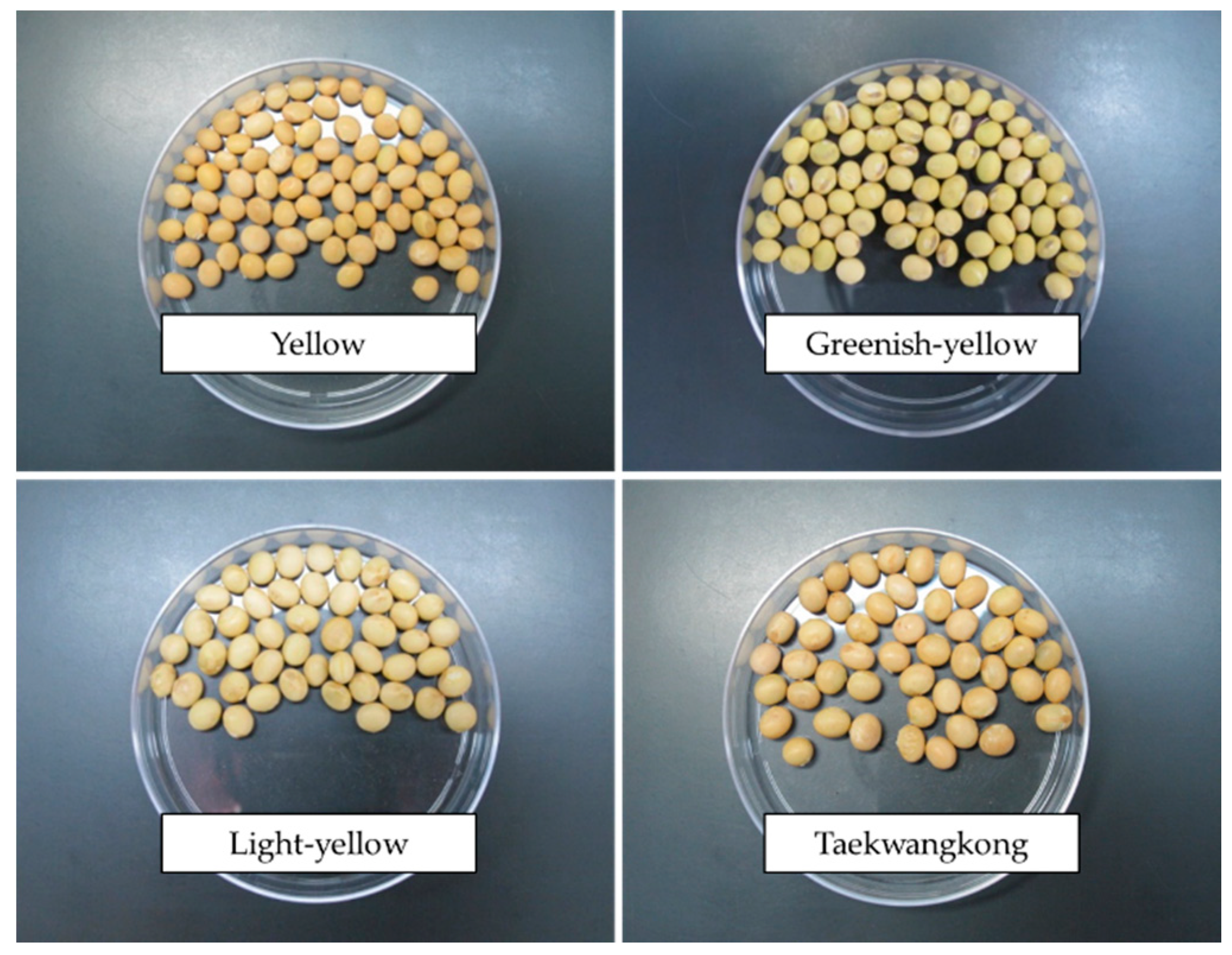
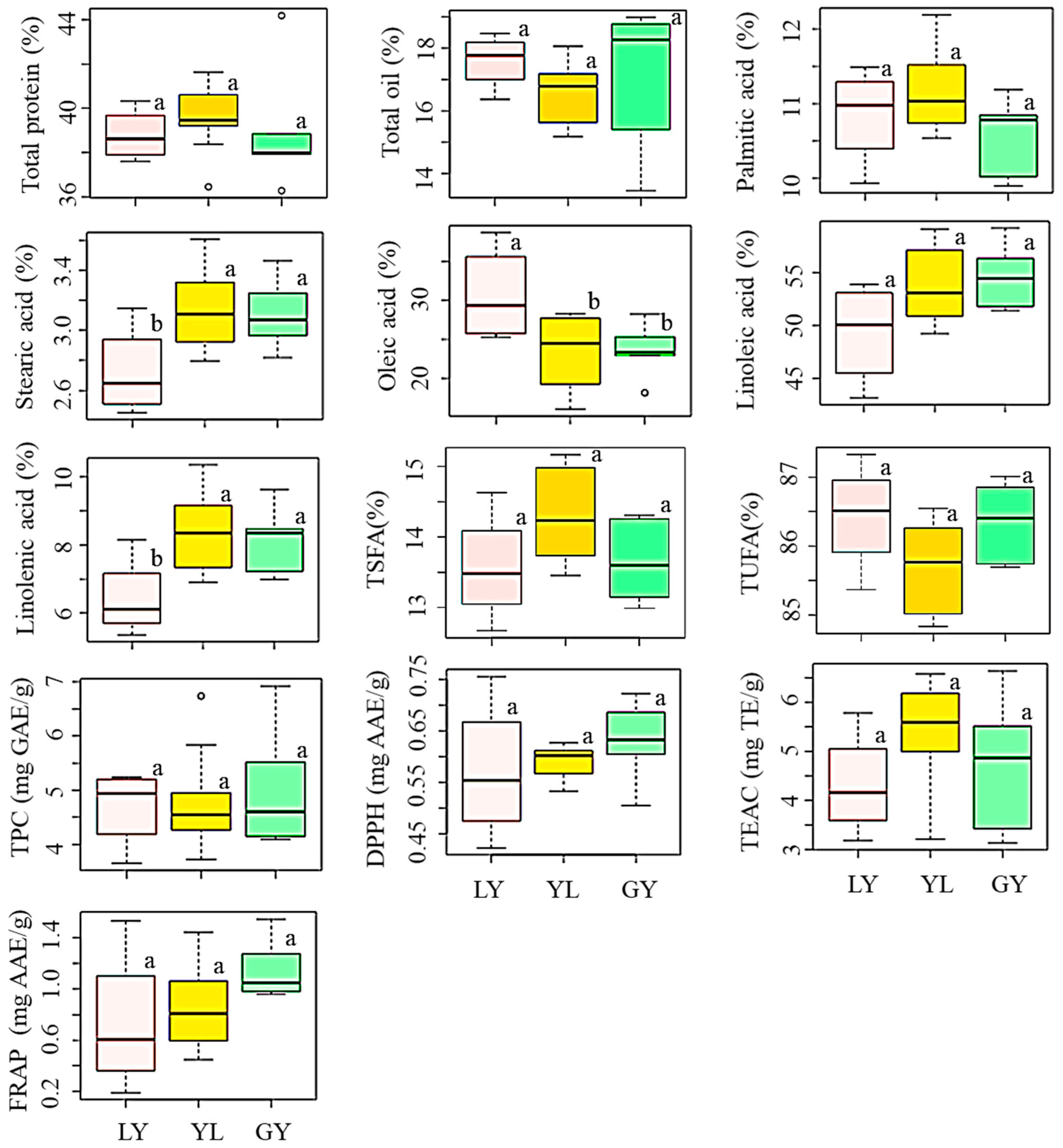
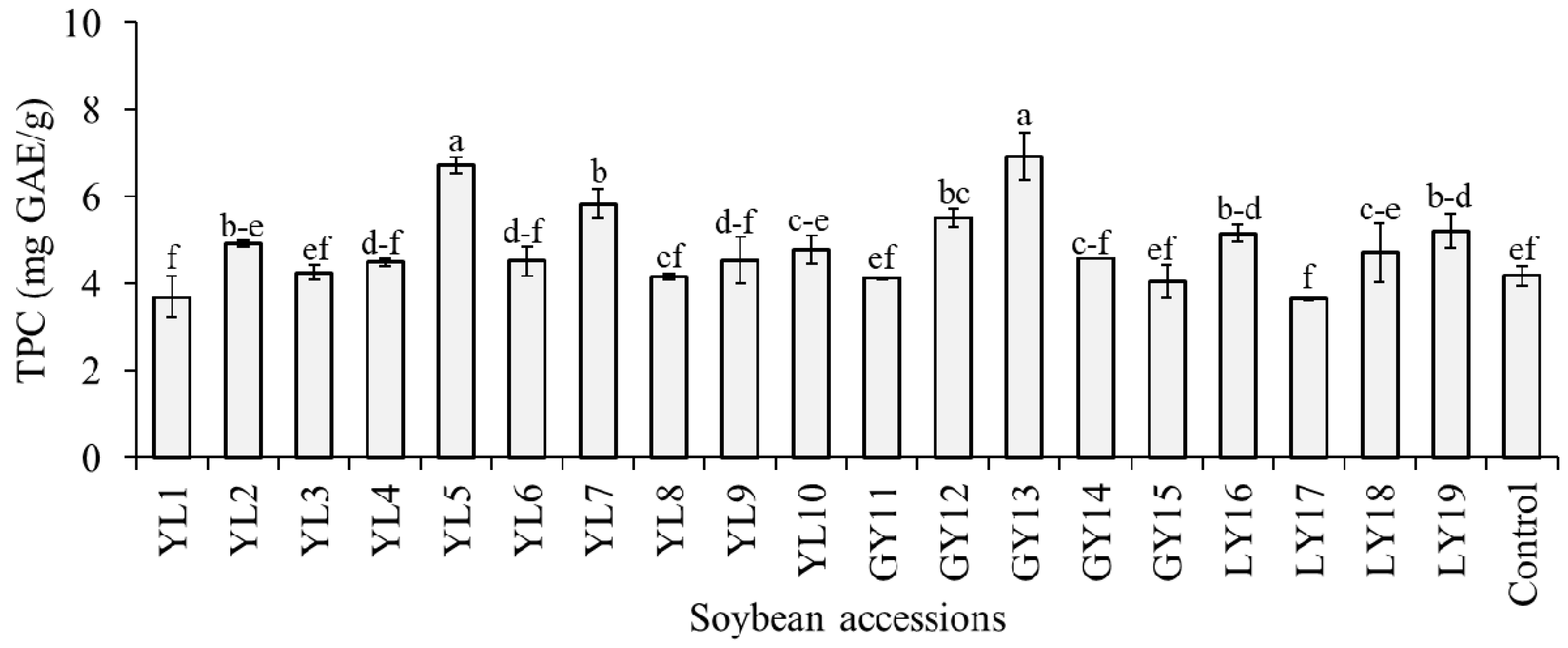
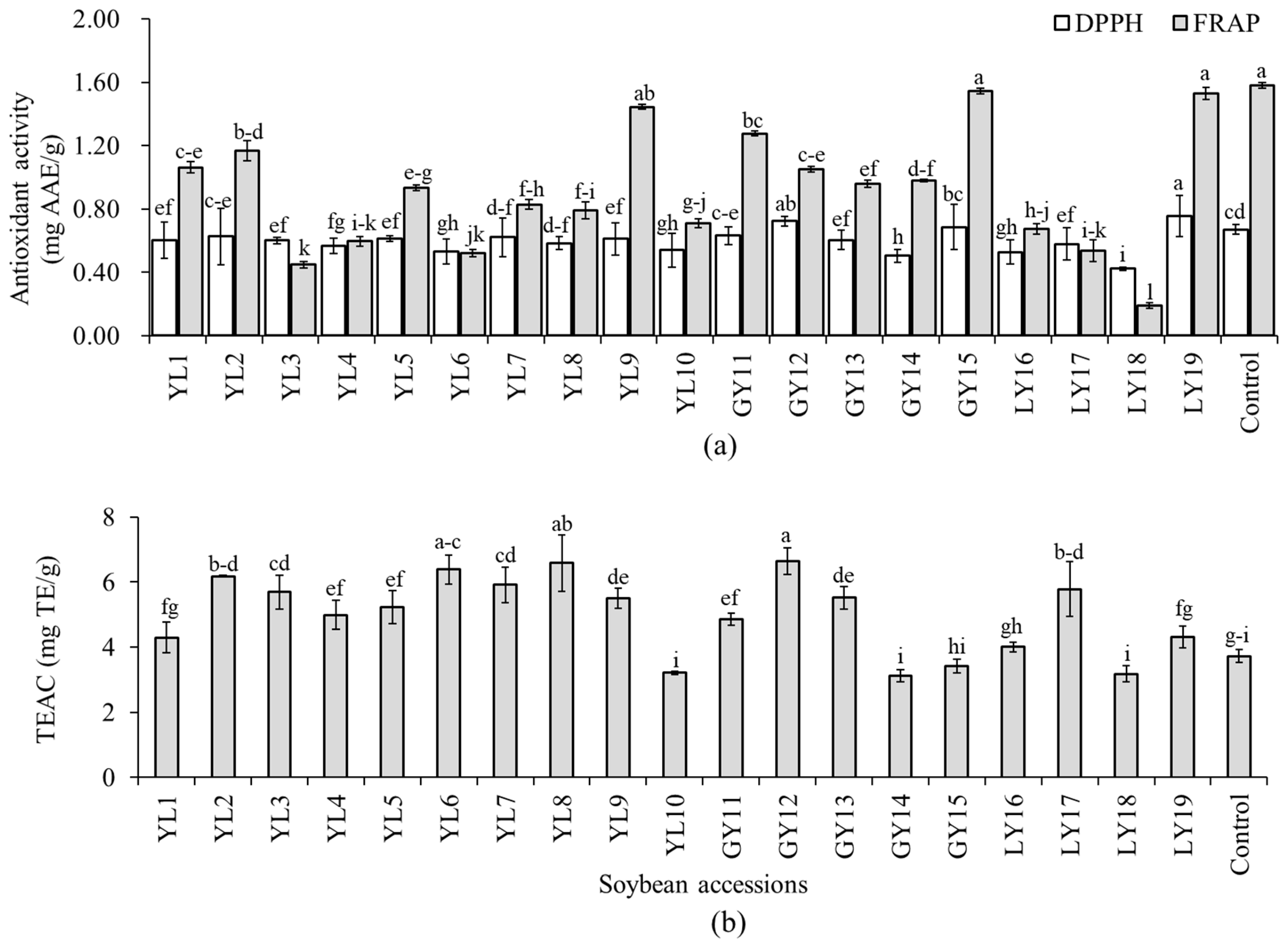
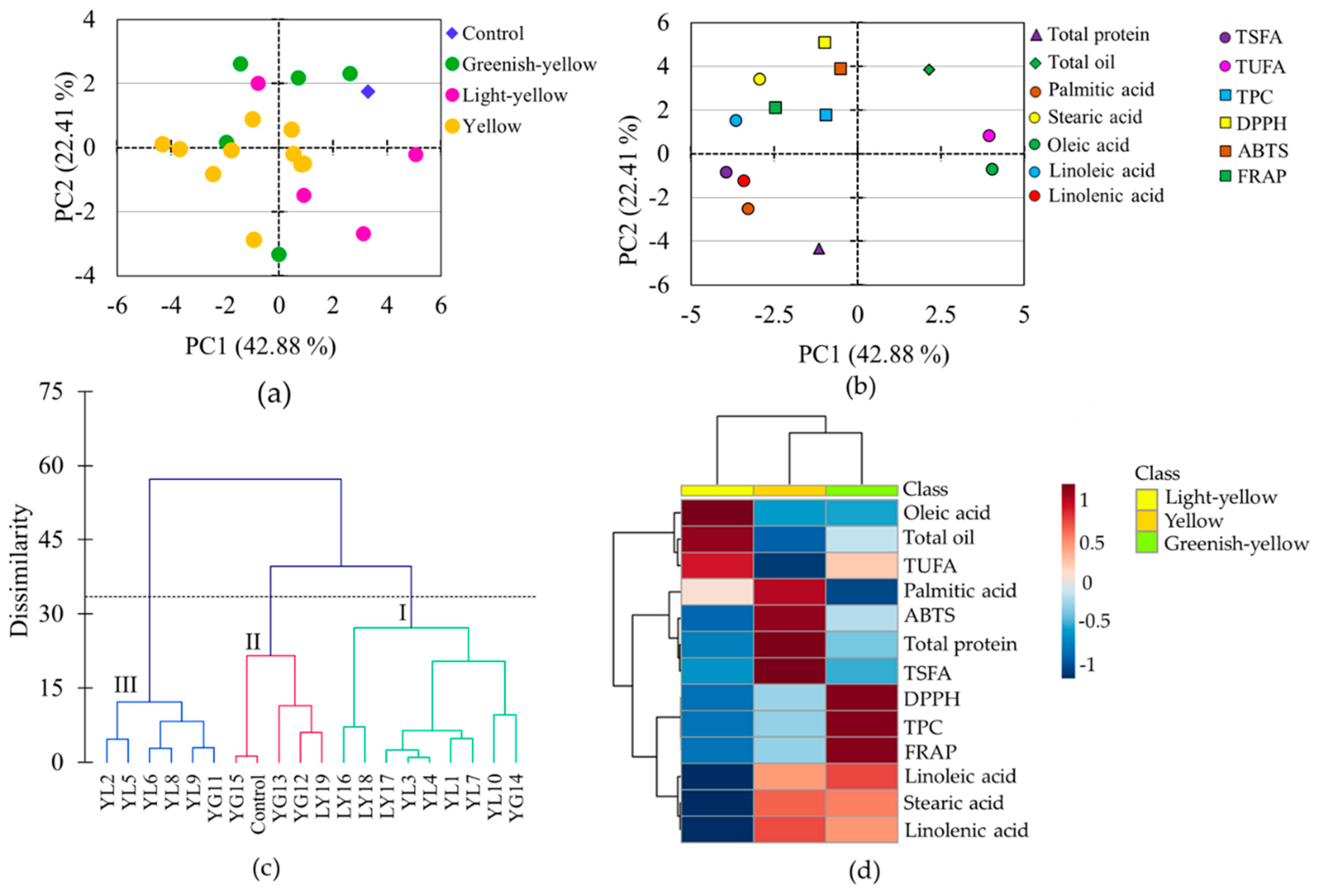
| Name | Introduction Number | Code | Total Protein (%) | Total Oil (%) |
|---|---|---|---|---|
| Yellow | ||||
| YJ208-1 | 024099 | YL1 | 41.63 ± 0.16 b | 16.75 ± 0.27 hi |
| Kongnamul-kong | 113218 | YL2 | 39.60 ± 0.21 e | 15.97 ± 0.29 jk |
| Nongrim51ho | 155963 | YL3 | 38.38 ± 0.06 h | 17.18 ± 0.08 f–h |
| PI467319 | 171080 | YL4 | 39.21 ± 0.15 f | 17.16 ± 0.18 gh |
| Hoseo | 229421 | YL5 | 41.34 ± 0.23 c | 15.48 ± 0.20 kl |
| Kongnamul-kong | 231360 | YL6 | 39.31 ± 0.11 ef | 16.81 ± 0.30 hi |
| Shinpaldalkong2ho | 263155 | YL7 | 40.37 ± 0.12 d | 18.06 ± 0.16 c–e |
| Uram | 263167 | YL8 | 39.31 ± 0.09 ef | 17.26 ± 0.48 f–h |
| GNU-2007-14613 | 274571 | YL9 | 36.46 ± 0.05 k | 15.63 ± 0.21 kl |
| Himeyudaga | 156272 | YL10 | 40.61 ± 0.11 d | 15.17 ± 0.32 l |
| Greenish-yellow | ||||
| Kongnamul-kong | 104690 | GY11 | 38.84 ± 0.08 g | 15.40 ± 0.39 kl |
| KLS87248 | 153844 | GY12 | 37.99 ± 0.04 i | 18.98 ± 0.12 a |
| Myeongjunamul-kong | 219581 | GY13 | 37.92 ± 0.05 i | 18.27 ± 0.16 b–d |
| Jungmo3008ho | 270002 | GY14 | 44.19 ± 0.08 a | 13.45 ± 0.21 m |
| GNU-2007-14723 | 274592 | GY15 | 36.28 ± 0.14 k | 18.77 ± 0.22 ab |
| Light-yellow | ||||
| Jangkong | 195514 | LY16 | 38.21 ± 0.20 hi | 18.46 ± 0.36 a–c |
| Chungnamyeongi-1997-3 | 263852 | LY17 | 40.32 ± 0.20 d | 16.37 ± 0.09 ij |
| Duruol | 269982 | LY18 | 39.03 ± 0.28 fg | 17.91 ± 0.25 c–e |
| CS00728 | 324099 | LY19 | 37.60 ± 0.15 j | 17.63 ± 0.33 e–g |
| Taekwangkong (Control) | 37.36 ± 0.04 j | 17.78 ± 0.44 d–f | ||
| Range (%) | 36.28–44.19 | 13.45–18.98 | ||
| Total mean (%) | 39.20 | 16.92 | ||
| CV(%) | 4.79 | 8.36 | ||
| Accession | Palmitic Acid | Stearic Acid | Oleic Acid | Linoleic Acid | Linolenic Acid | TSFA 1 | TUFA 2 |
|---|---|---|---|---|---|---|---|
| Yellow | |||||||
| YL1 | 10.54 ± 0.14 f | 3.17 ± 0.05 de | 28.23 ± 0.09 cd | 50.71 ± 0.14 gh | 7.34 ± 0.05 g | 13.72 ± 0.18 de | 86.28 ± 0.18 de |
| YL2 | 11.81 ± 0.07 b | 3.36 ± 0.03 bc | 16.02 ± 0.06 j | 58.46 ± 0.11 a | 10.35 ± 0.06 a | 15.17 ± 0.09 a | 84.83 ± 0.09 h |
| YL3 | 10.81 ± 0.69 ef | 2.92 ± 0.10 hi | 25.68 ± 0.38 d–f | 53.26 ± 0.80 d–f | 7.32 ± 0.41 g | 13.74 ± 0.79 de | 86.26 ± 0.79 de |
| YL4 | 10.54 ± 0.07 f | 2.92 ± 0.01 hi | 25.84 ± 0.03 c–f | 52.53 ± 0.04 d–g | 8.18 ± 0.01 f | 13.45 ± 0.07 ef | 86.55 ± 0.07 cd |
| YL5 | 11.52 ± 0.15 c | 3.60 ± 0.02 a | 19.26 ± 0.16 i | 57.10 ± 0.11 ab | 8.52 ± 0.11 ef | 15.12 ± 0.16 a | 84.88 ± 0.16 h |
| YL6 | 11.51 ± 0.03 c | 3.05 ± 0.03 e–h | 17.56 ± 0.06 ij | 59.05 ± 0.08 a | 8.83 ± 0.03 de | 14.56 ± 0.03 bc | 85.44 ± 0.03 fg |
| YL7 | 10.74 ± 0.04 f | 3.13 ± 0.03 de | 28.33 ± 0.11 c | 50.91 ± 0.07 gh | 6.90 ± 0.05 gh | 13.87 ± 0.05 d | 86.13 ± 0.05 e |
| YL8 | 11.24 ± 0.05 cd | 3.32 ± 0.04 c | 23.36 ± 0.11 f–h | 52.91 ± 0.12 d–g | 9.16 ± 0.06 cd | 14.56 ± 0.08 bc | 85.44 ± 0.08 fg |
| YL9 | 10.82 ± 0.02 ef | 3.09 ± 0.01 ef | 22.22 ± 0.04 h | 54.33 ± 0.06 cd | 9.54 ± 0.06 bc | 13.91 ± 0.02 d | 86.09 ± 0.02 e |
| YL10 | 12.19 ± 0.02 a | 2.80 ± 0.03 ij | 27.71 ± 0.15 c–e | 49.22 ± 0.12 hi | 8.08 ± 0.06 f | 14.98 ± 0.04 a | 85.02 ± 0.04 h |
| Greenish-yellow | |||||||
| GY11 | 11.19 ± 0.02 d | 3.07 ± 0.01 e–g | 18.11 ± 0.05 ij | 59.15 ± 0.05 a | 8.48 ± 0.04 ef | 14.26 ± 0.02 c | 85.74 ± 0.02 f |
| GY12 | 10.84 ± 0.13 ef | 3.46 ± 0.31 b | 22.90 ± 6.19 gh | 54.44 ± 5.37 cd | 8.35 ± 1.00 f | 14.31 ± 0.18 bc | 85.69 ± 0.18 fg |
| GY13 | 9.90 ± 0.03 g | 3.25 ± 0.01 cd | 23.31 ± 0.13 f–h | 56.32 ± 0.09 bc | 7.22 ± 0.02 g | 13.15 ± 0.03 fg | 86.85 ± 0.03 bc |
| GY14 | 10.78 ± 0.09 ef | 2.82 ± 0.02 ij | 25.34 ± 0.16 e–g | 51.43 ± 0.18 fg | 9.63 ± 0.09 b | 13.60 ± 0.11 de | 86.40 ± 0.11 de |
| GY15 | 10.02 ± 0.04 g | 2.96 ± 0.03 f–h | 28.22 ± 0.03 cd | 51.79 ± 0.08 e–g | 7.00 ± 0.01 gh | 12.99 ± 0.07 gh | 87.01 ± 0.07 ab |
| Light-yellow | |||||||
| LY16 | 9.94 ± 0.07 g | 2.73 ± 0.04 j | 38.74 ± 0.49 a | 43.22 ± 0.43 j | 5.37 ± 0.07 j | 12.67 ± 0.10 h | 87.33 ± 0.10 a |
| LY17 | 10.85 ± 0.02 ef | 2.57 ± 0.01 k | 26.13 ± 0.05 c–e | 52.30 ± 0.03 d–g | 8.15 ± 0.04 f | 13.42 ± 0.02 ef | 86.58 ± 0.02 cd |
| LY18 | 11.10 ± 0.02 de | 2.45 ± 0.00 k | 32.60 ± 0.15 b | 47.81 ± 0.13 i | 6.04 ± 0.04 i | 13.55 ± 0.02 de | 86.45 ± 0.02 de |
| LY19 | 11.49 ± 0.04 c | 3.15 ± 0.01 de | 25.33 ± 0.14 e–g | 53.86 ± 0.06 de | 6.18 ± 0.03 i | 14.63 ± 0.06 b | 85.37 ± 0.06 g |
| Taekwangkong | 9.88 ± 0.04 g | 2.94 ± 0.01 g–i | 32.18 ± 0.04 b | 48.38 ± 0.04 i | 6.62 ± 0.05 h | 12.82 ± 0.02 gh | 87.18 ± 0.01 ab |
| Range (%) | 9.90–12.19 | 2.45–3.60 | 16.02–38.74 | 43.22–59.15 | 5.37–10.35 | 12.67–15.17 | 84.83–87.33 |
| Mean (%) | 10.89 | 3.04 | 25.35 | 52.86 | 7.86 | 13.92 | 86.08 |
| CV(%) | 5.91 | 9.49 | 21.63 | 7.63 | 16.66 | 5.40 | 0.87 |
| Variables | PC1 | PC2 | PC3 | PC4 |
|---|---|---|---|---|
| Total protein | 1.24 | 17.86 | 0.01 | 1.70 |
| Total oil | 4.35 | 13.91 | 15.57 | 0.27 |
| Palmitic acid | 10.20 | 5.99 | 0.52 | 6.72 |
| Stearic acid | 8.21 | 11.07 | 0.95 | 1.76 |
| Oleic acid | 15.36 | 0.47 | 0.51 | 5.83 |
| Linoleic acid | 12.53 | 2.17 | 0.13 | 7.32 |
| Linolenic acid | 11.01 | 1.41 | 6.03 | 11.19 |
| TPC 1 | 0.84 | 2.98 | 24.89 | 15.01 |
| DPPH 2 | 0.92 | 24.44 | 5.07 | 3.22 |
| TEAC 3 | 5.75 | 4.18 | 12.03 | 24.88 |
| FRAP 4 | 0.25 | 14.17 | 32.34 | 7.24 |
| TSFA 5 | 14.68 | 0.67 | 0.98 | 7.43 |
| TUFA 6 | 14.68 | 0.67 | 0.98 | 7.43 |
| Eigenvalue | 5.57 | 2.91 | 1.41 | 1.13 |
| Variability (%) | 42.88 | 22.41 | 10.81 | 8.72 |
| Cumulative (%) | 42.88 | 65.29 | 76.10 | 84.82 |
Publisher’s Note: MDPI stays neutral with regard to jurisdictional claims in published maps and institutional affiliations. |
© 2021 by the authors. Licensee MDPI, Basel, Switzerland. This article is an open access article distributed under the terms and conditions of the Creative Commons Attribution (CC BY) license (https://creativecommons.org/licenses/by/4.0/).
Share and Cite
Choi, Y.-M.; Yoon, H.; Shin, M.-J.; Lee, Y.; Hur, O.S.; Lee, B.C.; Ha, B.-K.; Wang, X.; Desta, K.T. Metabolite Contents and Antioxidant Activities of Soybean (Glycine max (L.) Merrill) Seeds of Different Seed Coat Colors. Antioxidants 2021, 10, 1210. https://doi.org/10.3390/antiox10081210
Choi Y-M, Yoon H, Shin M-J, Lee Y, Hur OS, Lee BC, Ha B-K, Wang X, Desta KT. Metabolite Contents and Antioxidant Activities of Soybean (Glycine max (L.) Merrill) Seeds of Different Seed Coat Colors. Antioxidants. 2021; 10(8):1210. https://doi.org/10.3390/antiox10081210
Chicago/Turabian StyleChoi, Yu-Mi, Hyemyeong Yoon, Myoung-Jae Shin, Yoonjung Lee, On Sook Hur, Bong Choon Lee, Bo-Keun Ha, Xiaohan Wang, and Kebede Taye Desta. 2021. "Metabolite Contents and Antioxidant Activities of Soybean (Glycine max (L.) Merrill) Seeds of Different Seed Coat Colors" Antioxidants 10, no. 8: 1210. https://doi.org/10.3390/antiox10081210
APA StyleChoi, Y.-M., Yoon, H., Shin, M.-J., Lee, Y., Hur, O. S., Lee, B. C., Ha, B.-K., Wang, X., & Desta, K. T. (2021). Metabolite Contents and Antioxidant Activities of Soybean (Glycine max (L.) Merrill) Seeds of Different Seed Coat Colors. Antioxidants, 10(8), 1210. https://doi.org/10.3390/antiox10081210








